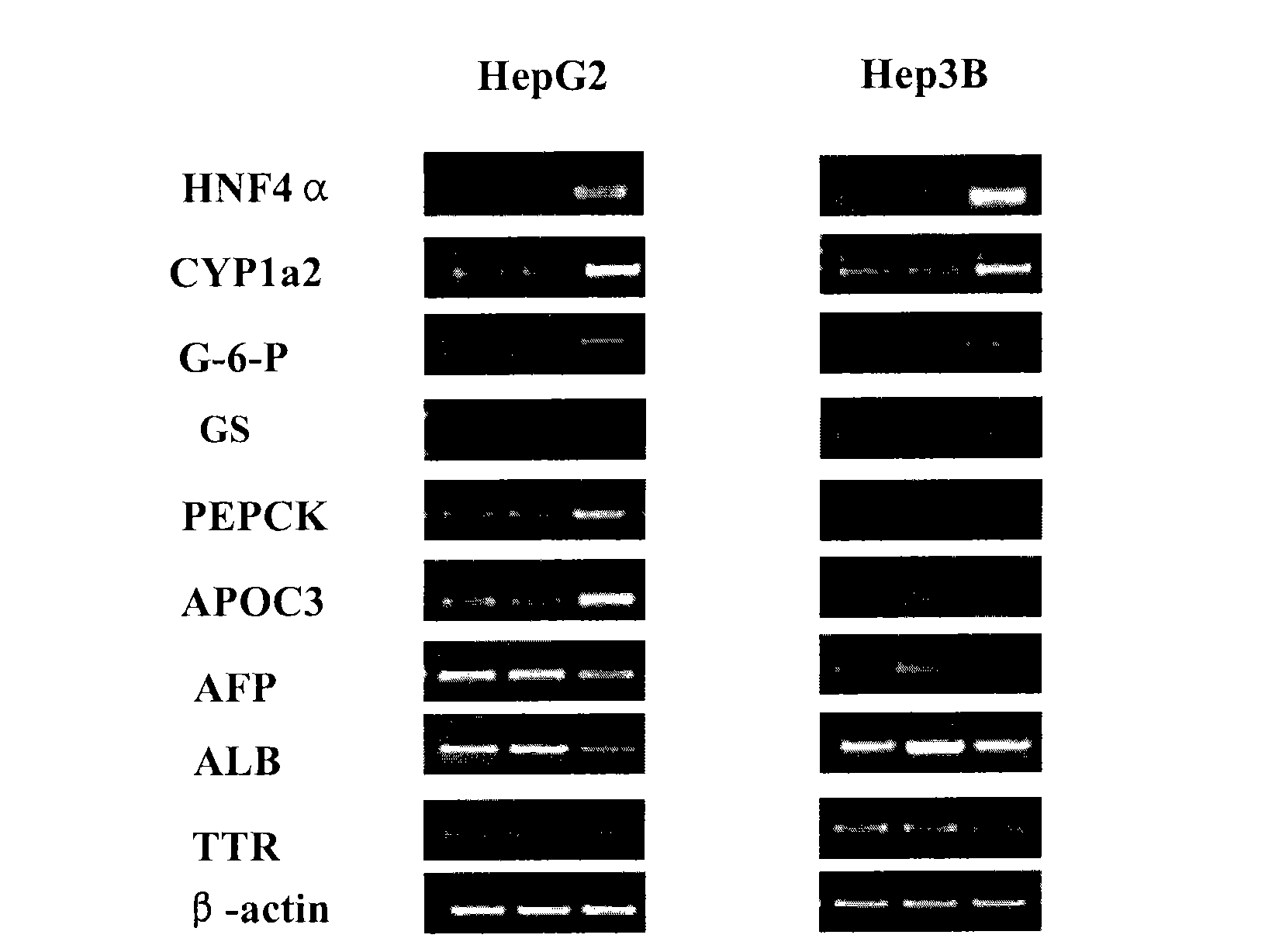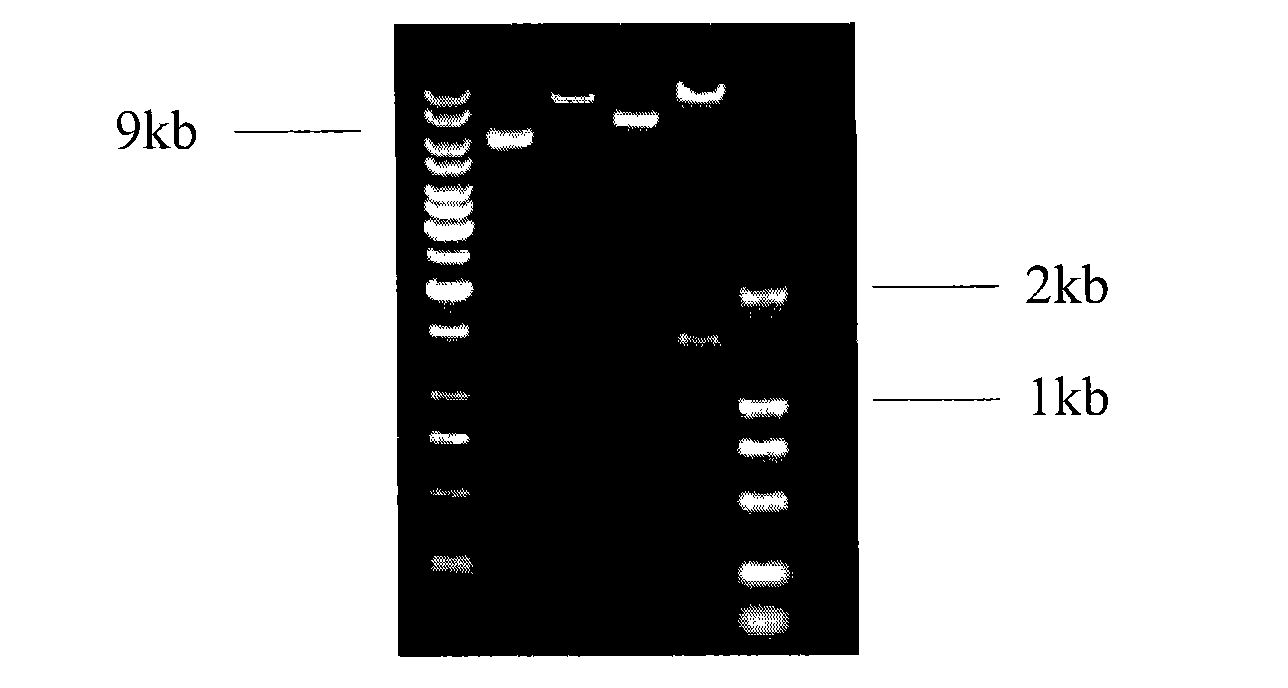Treatment on human malignant solid tumor by HNF4 alpha inducement and differentiation
A solid tumor, alpha protein technology, applied in the fields of cell biology, medicine, and molecular biology, can solve the problems of unscreened drugs or proteins for differentiation therapy, inability to differentiate tumors, and reducing the tumorigenic effect of cancer cells.
- Summary
- Abstract
- Description
- Claims
- Application Information
AI Technical Summary
Problems solved by technology
Method used
Image
Examples
Embodiment 1
[0081] RT-PCR detection of expression of HNF4α gene and hepatocyte-related functional genes in human liver tumor cell line
[0082] 1. The commercially available conventional liver tumor cell lines Huh-7, Hep3B, and HepG2 were all mixed with 8×10 5 Inoculated in a six-well plate per plate, cultivated with fresh culture medium containing 10% fetal bovine serum, extracted cellular RNA the next day, and measured OD with a spectrophotometer 260 Values were formulated into working concentrations (1 μg / μl and 0.1 μg / μl), and RNA integrity was detected by 1% agarose gel electrophoresis.
[0083] 2. RT-PCR: Take 4 μg RNA, 2 μl random primers, add DEPC water to 33 μl, set at 70°C for 5 minutes, and set at 0°C for 5 minutes, then add 10 μl 5×Buffer, 3 μl dNTP, 2 μl RNA reverse transcriptase and 2 μl RNase inhibitor After mixing, place at 37°C for 1.5h to obtain the reverse transcription product. After diluting the reverse transcription product, 1 μl was taken as a template for PCR a...
Embodiment 2
[0092] Construction of recombinant replication-defective adenovirus AdHNF4α expressing HNF4α
[0093] 1. Obtaining the HNF4α 1425bp cDNA fragment: Design and synthesize primers according to the human HNF4α cDNA sequence. Sense primer (Bgl II restriction site added at the 5' end): 5'-CCG AGA TCT AGA ATGCGA CTC TCC AAA ACC-3' (SEQ ID NO: 21). Antisense primer (EcoR V restriction site added at the 5' end): 5'-CGC GAT ATC GGC TTG CTA GAT AAC TTC CTG CT-3' (SEQ ID NO: 22).
[0094] The HNF4α cDNA fragment was amplified by PCR, and the product was electrophoresed on 1% agarose gel to identify the size of the fragment, and the gel was harvested and placed in an Eppendorf tube, and the weight of the gel was weighed. Add 200ml of NT solution / 100mg gel into the Eppendorf tube, incubate at 50°C for 5-10min until the gel melts, pass the liquid through the column, centrifuge at 13,000rpm for 1min, add 600μl NT3 buffer, and centrifuge at 13,000rpm for 2min. 30 μl of double-distilled water...
Embodiment 3
[0100] RT-PCR and Western blot detection of HNF4α expression after AdHNF4α infection of human liver tumor cell lines
[0101] 1. Both human liver tumor cell lines HepG2 and Hep3B were treated with 5×10 5 / dish was inoculated in a six-well plate, and the virus AdHNF4α was infected with MOI 40 and 100 respectively. After 24 hours, the fresh DMEM medium containing 10% fetal bovine serum was replaced, and GFP expression was observed after 3 days ( Figure 6 ). Total RNA was extracted with the Trizol kit, reverse transcription was performed for 2 hours, and 1 μl of the diluted reverse transcription product was used as a template for HNF4α PCR amplification. The reaction system is as follows.
[0102]
[0103]The reaction conditions were 95°C for 30s, 55°C for 30s, 72°C for 90s, 27 cycles.
[0104] The RT-PCR products were identified by 1.5% agarose gel electrophoresis, and after the image was scanned, densitometric scanning and sequencing analysis were performed with Multy-An...
PUM
 Login to View More
Login to View More Abstract
Description
Claims
Application Information
 Login to View More
Login to View More - R&D Engineer
- R&D Manager
- IP Professional
- Industry Leading Data Capabilities
- Powerful AI technology
- Patent DNA Extraction
Browse by: Latest US Patents, China's latest patents, Technical Efficacy Thesaurus, Application Domain, Technology Topic, Popular Technical Reports.
© 2024 PatSnap. All rights reserved.Legal|Privacy policy|Modern Slavery Act Transparency Statement|Sitemap|About US| Contact US: help@patsnap.com










